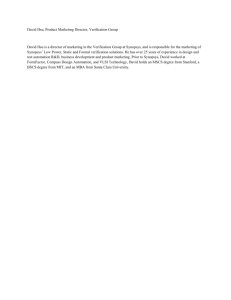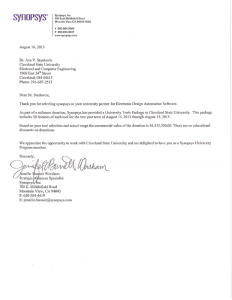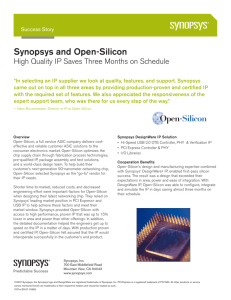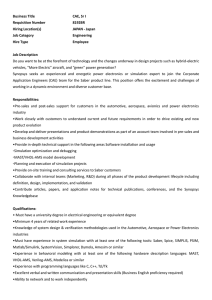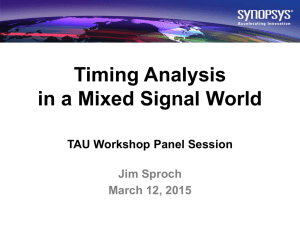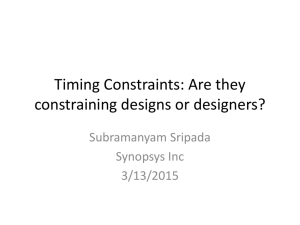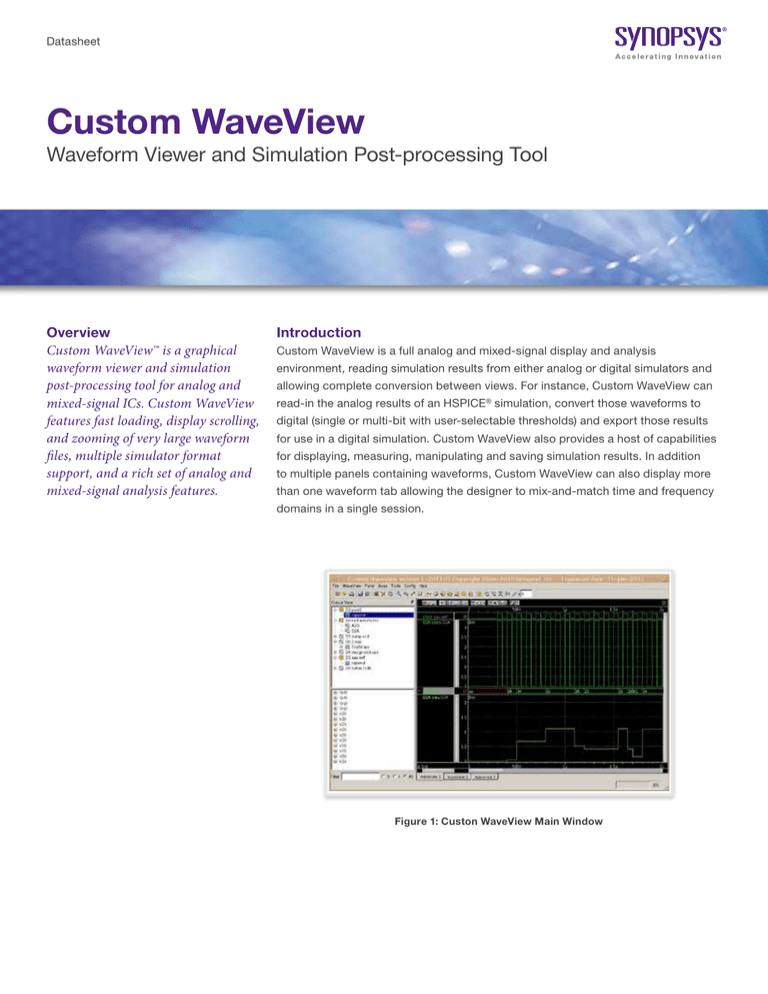
Datasheet
Custom WaveView
Waveform Viewer and Simulation Post-processing Tool
Overview
Custom WaveView™ is a graphical
waveform viewer and simulation
post-processing tool for analog and
mixed-signal ICs. Custom WaveView
features fast loading, display scrolling,
and zooming of very large waveform
files, multiple simulator format
support, and a rich set of analog and
mixed-signal analysis features.
Introduction
Custom WaveView is a full analog and mixed-signal display and analysis
environment, reading simulation results from either analog or digital simulators and
allowing complete conversion between views. For instance, Custom WaveView can
read-in the analog results of an HSPICE® simulation, convert those waveforms to
digital (single or multi-bit with user-selectable thresholds) and export those results
for use in a digital simulation. Custom WaveView also provides a host of capabilities
for displaying, measuring, manipulating and saving simulation results. In addition
to multiple panels containing waveforms, Custom WaveView can also display more
than one waveform tab allowing the designer to mix-and-match time and frequency
domains in a single session.
Figure 1: Custon WaveView Main Window
Features
Custom WaveView supports many
different time and frequency domain
Waveform Display
Cursors
waveform types, such as:
Monitors
``
Analog
Measurement Tool
``
Digital
``
Smith chart
Toolboxes and Assistants
``
Polar plot
Eye Diagrams
DFT/FFT
``
2-D, 3-D sweep
ADC Design Toolbox
``
Eye diagram
Jitter Toolbox
``
Histogram
Waveform Post-processing with the Mixed-Signal Equation Builder
Extensible and Open
Measurements
Cursors, Monitors and the
Customizable GUI
Measurement Tool
Industry Standard Design Platform Integrations
Cursors
All Supported File Formats
Custom WaveView provides an unlimited
Benefits
``
Synopsys
``
High-performance waveform database
I/O to quickly access large amounts of
yy CustomSim™ , FineSim™, FineSim
Pro, HSPICE, and VCS®
``
Cadence Design Systems
simulation data
``
Extensive mixed-signal display
functions and analysis capabilities to
extract measurements from simulation
yy Spectre/RF, UltraSim, and Incisive
``
Mentor Graphics
yy ModelSim, Eldo, ADMS, ADiT,
HyperLynx
results
``
Single waveform tool for multiple
simulators
``
Built-in support for HSPICE
.MEASURE command and parametric
plots for .ALTER simulations
``
Transient, AC, RF, mixed-signal
display and analysis
``
Optional Tcl API for programming
complex user post-processing scripts
``
Flexible waveform grouping—add
multiple waveform views, either from
different simulator runs on the same
circuit netlist or from different netlists
Waveform Display
Custom WaveView’s advanced user
interface allows the user to browse
waveform data hierarchies and then
drag-and-drop multiple selected
signals into a waveform display window.
horizontal mode, these cursors can be
moved around the waveform and display
“X-at-Y” information on-screen.
Monitors
Monitors can be added to the waveform
panels to perform more complex
measurements. Monitors include
Derivative, Inverse Derivative, Delta
Value, Cursor Average, Minimum/
Maximum/Average, Peak-to-Peak and
RMS values of a given waveform.
have one or more non-overlapping
Custom WaveView’s powerful
panels. Panels in a window can be
Measurement tool provides a wealth
arranged as either a vertical stack or as
of domain-specific measurements
independent rows and columns. Rows
that simplify design analysis. The
and columns may be vertical, horizontal,
Measurement tool provides rapid-on
or tiled.
waveform display of over 35 types
Custom WaveView is completely
``
Waveform display via data drag-and-
``
Hierarchy browser and signal list
drop
®
``
Signal search with pattern-matching
and supports cross-probing with the
and wildcard; drag-and-drop from
Custom Designer SE schematic editor.
search results
Custom WaveView will also read many
``
User-definable Hot Keys
common SPICE, FastSPICE, and Verilog
``
Recent Files List
simulator waveform files from Synopsys,
``
Stack or Row column signal display
Mentor, and Cadence.
``
Save and Restore session
Custom WaveView
waveforms. Set to either the vertical or
Measurement Tool
Waveform display includes:
Custom Designer implementation tool
interactive on-screen measurement of
Waveforms in the display window can
Single Waveform Tool for
Multiple Simulators
integrated with Synopsys’ Galaxy
number of cursors specifically for
of measurements. Measurements
are persistent across sessions and
can be “replayed” against a new
set of simulation results as needed
(see Figure 2). As simulation results
change, measurements are updated
automatically, presenting the user
with the latest information available.
The Measurement tool supports many
measurements including time domain,
frequency domain, statistical, level,
S-domain, and RF.
2
Eye Diagrams
Custom WaveView’s eye diagram
capability allows users to easily create
a folded eye diagram from complex
waveforms. The eye diagram is
constructed by automatically extracting
the clock cycle, or by reference to an
ideal clock, or to an external signal.
Once constructed, the Automatic Eye
Measurement tool can take eye opening
or aperture measurements as well as
create a jitter histogram. Figure 3 shows
a typical eye diagram with cursors used
to measure the eye width.
Waveform Post-processing
Figure 2: Measurement Tool
A-to-D; D-to-A Conversion
Analog waveforms can be converted to
single-bit or multi-bit logic waveforms
using user-specified threshold criteria
(See figure 4). Similarly, logic waveforms
can be converted to analog waveforms
(see figure 5) based on user-specified
analog levels using either fixed-rate
sampling or value transition sampling.
Data Reduction and Export
Redundant data points can be
automatically removed based on a userspecified error tolerance. Data can then
be exported and saved using several
different formats such as tabulated,
SPICE PWL, WDF, VCD, and M-file (MatLab).
Figure 3: Eye Diagram
DFT/FFT
Custom WaveView supports FFT and
DFT operations on time-domain data
using various windowing functions (see
figure 6). FFT/DFT will also automatically
measure the signal-to-noise ratio (SNR),
total harmonic distortion (THD), signalto-noise and distortion ratio (SNDR), and
effective number of bits (ENB).
Measurements also include:
``
Snap-to-wave feature
``
Measure update on reload
``
Glitch detection
``
Measurement export (as “.Meas”)
``
On-screen measure drawing
``
HSPICE measure tool
Custom WaveView
Figure 4: Analog-to-Digital Conversion
3
Toolboxes and Assistants
Custom WaveView’s toolboxes
are provided to simplify specific
measurements for a variety of common
activities in waveform analysis.
Assistants are provided to simplify
common tasks that improve accuracy
and customer productivity.
ADC Design Toolbox
Custom WaveView’s ADC toolbox
(see figure 7) provides the necessary
information when working with analogto-digital converters (ADCs). This
toolbox, with a simple drag-and-drop
of a waveform, can extract the common
measurements required to proof ADC
designs including:
Figure 5: Digital-to-Analog Conversion
DC Static Characteristics
Histogram, INL/DNL, min./max. values,
and their standard deviations
AC Dynamic Characteristics
Using either Coherent or Window
Sampling, the ADC toolbox measures
noise parameters SNR, THD, SNDR,
SFDR and ENOB and the frequencydomain power spectrum
Jitter Toolbox
The built-in Jitter-vs.-Time toolbox (see
figure 8) can be used to analyze clock
jitter between any logic and analog
target signal with respect to a reference
signal. The reference signal can be an
analog or logic signal from simulation
Figure 6: FFT
output, or an ideal signal defined using
the width/period/delay parameters. The
jitter can be measured against the rise
and fall edges of a reference signal.
Waveform Post-processing
with the Equation Builder
Post-processing calculations using:
``
Graphical Calculator
``
Graphing Language
``
Equation builder
Custom WaveView hosts a powerful,
scriptable mixed-signal equation
Custom WaveView
Figure 7: ADC Toolbox
4
language that can be used to construct
any number of custom views of existing
waveforms using multi-file, multi-trace
mixed-signal data, or to extract stimuli
from existing netlist and modify them
for the successive simulation runs. The
Equation Builder (see Figure 9) contains
a large number of built-in mathematic,
RF, logic, waveform and measurement
functions that can be mixed-andmatched as needed to create custom
measurements. These custom
measurements can be saved as macros
and replayed against any simulation
results as needed. Additionally, the
Equation Builder contains functions that
can shift waveforms in time, making it
Figure 8: Jitter Toolbox Plot
easy to compare results that occurred
at different simulated times. Waveforms
can also be smoothed to reduce extra
time points and exported to other
simulations as stimuli leading to faster
analog simulations downstream.
Extensible and Open
Custom WaveView is open and
extensible and can be controlled in
either GUI or Batch mode with scripting.
The GUI is also extensible, allowing CAD
teams to craft custom measurements
and provide them across their
organizations through the regular
menu system.
Optional regression Scripting
with the Analysis Command
Environment
The Analysis Command Environment
(ACE) is a Tcl-based extension language
that provides near-complete control of
Custom WaveView (via the ACE option).
The ACE scripting environment contains
hundreds of functions and can control
the GUI, the waveform panels, the menu
system or the measurement capabilities
of either tool. Often used by CAD teams
to extend the tools, the ACE scripting
capability can also be used to perform
Figure 9: Equation Builder
Regression Scripting, allowing designers
Custom WaveView
5
CustomExplorer Ultra
CustomExplorer
Custom WaveView
Configuration management
4
Corners setup
4
Simulation job control
4
Results analysis
4
AMS debugger
4
SPICE debugger
4
4
Waveform compare
4
4
tcl Scripting
4
4
(option)
Waveform display
4
4
4
Table 1: CustomExplorer Family Products and Features
to make changes to their design and
Supported File Formats
yy CSDF (ASCII)
then replay a wide variety of analyses
Custom WaveView provides support for
yy Novas FSDB (Binary)
in batch mode, freeing the designer to
over 45 different file formats, providing
yy Legend (Tr0 Derivative)
work on other aspects of the design.
the highest support of simulation file
yy SmartSPICE (Raw Derivative)
Encapsulating these analyses also
formats in the industry.
yy Five proprietary simulator formats
means sharing best design practices
across an organization to improve
quality and simplify the collection of
data for design reviews.
Customizable GUI
The GUI is fully customizable, and bind
Supported Simulator Formats
``
Synopsys
yy CustomSim and CustomSim FT
(HSIM, XA and NanoSim – WDF,
WDB, .Out and Vector)
yy FineSim, FineSim Pro (FSDB),
keys can be assigned for any menu
HSPICE and HSPICE RF (.Tr0, .Ac0,
function or waveview control button
.Sw0… – Binary and ASCII)
action.
Industry-standard Design
Platform Integrations
Custom WaveView is also integrated
into industry-standard design platforms
to help maximize designer productivity
during the design phase. A native
integration of these tools into Synopsys’
Custom Designer system helps form a
complete environment for analog block
yy Spectre (PSF, WSF—Binary
and ASCII)
yy UltraSim (PSF, WSF—Binary and
ASCII)
Data
yy Text table data and Comma
Separated Values (CSV)
``
PostScript
``
EMF
``
PNG
``
BMP
yy PSPICE (DAT)
Platform Support
yy Incisive (VCD)
``
Solaris 32- and 64-bit
``
Mentor Graphics
design platform integrations include:
yy ADMS (WDB and JWDB)
``
Mentor Graphic: Design Architect® IC
yy Tektronix Agilent and Lecroy Scope
``
JPEG
``
Cadence Design Systems
yy Eldo (COU 4.3, 4.7 and Tr0)
Debugging Environment
yy BIS Models
Supported Plot Output File Formats
cell-based and custom design. Other
``
JEDAT: Asca Circuit Design and
``
Data Formats
yy Saber (AI/PL – Binary and ASCII)
yy ModelSim (WLF)
Composer and ADE
Synopsys
yy VCS (VCD and VPD)
authoring in a single platform for both
``
Cadence Design Systems: Virtuoso®
are also available—please contact
yy ADiT (Tr0 and Tb0)
``
Red Hat Enterprise Linux version 4
and 5 (AS, ES, WS)
``
SUSE Linux 9.0 and 10.0 and 5
(AS, ES, WS) 9.0 and 10.0
``
Microsoft Windows XP
yy HyperLynx (CSV)
``
Others
yy Mathworks (.mat format)
yy Agilent ADS (.ds—Binary and
TouchStone S-Parameters—ASCII)
Custom WaveView
6
Features
Input File Formats
Cadence Spectre PSF
Cadence Spectre WSF
Cadence PSPICE DAT
Cadence Incisive VCD
Cadence Ultrasim WDF
Mentor Eldo cou
Mentor Eldo WDB
Mentor ADiT tr0
Mentor ADiT tb0
Mentor Eldo JWDB
Novas FSDB
Other SPICE raw
Other Text txt
Other Text csv
Synopsys WDF
Synopsys HSPICE tr#
Synopsys HSPICE sw#
Synopsys HSPICE ac#
Synopsys HSPICE nw#
Synopsys HSPICE mt#
Synopsys HSPICE RF .ac#
Synopsys HSPICE RF .sw#
Synopsys HSPICE RF .ev#
Synopsys HSPICE RF .fe#
Synopsys HSPICE RF .hb#
Synopsys HSPICE RF .hl#
Synopsys HSPICE RF .ls#
Synopsys HSPICE RF .ss#
Synopsys HSPICE RF .pn#
Synopsys HSPICE RF .hr#
Synopsys HSPICE RF .xf#
Synopsys HSPICE RF .ev#
Synopsys HSPICE RF .sn#
Synopsys HSPICE RF .sc#
Synopsys HSPICE RF .tr#
Synopsys HSPICE RF Citi
Synopsys HSPICE RF Touchstone
Synopsys Starsim xp0
Synopsys NanoSim out
Synopsys NanoSim WDF
Synopsys NanoSim CSDF
Synopsys HSIM WDF
Synopsys HSIM out
Synopsys HSIM hsim
Synopsys VCS vcd
Synopsys VCS vpd
Synopsys, Inc. 700 East Middlefield Road Mountain View, CA 94043 www.synopsys.com
©2013 Synopsys, Inc. All rights reserved. Synopsys is a trademark of Synopsys, Inc. in the United States and other countries. A list of Synopsys trademarks is
available at http://www.synopsys.com/copyright.html. All other names mentioned herein are trademarks or registered trademarks of their respective owners.
04/13.RP.CS2894.

